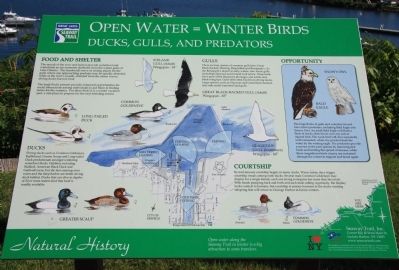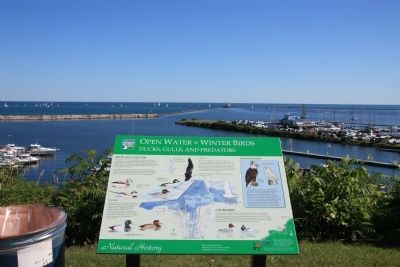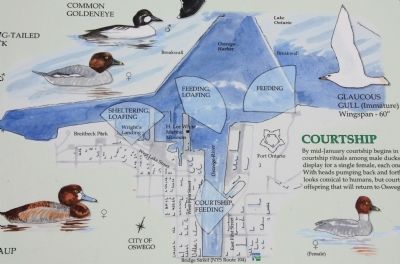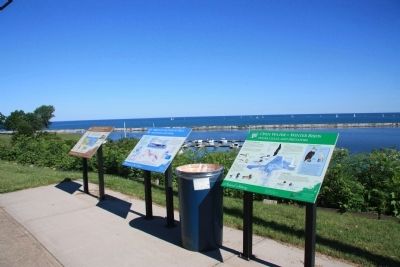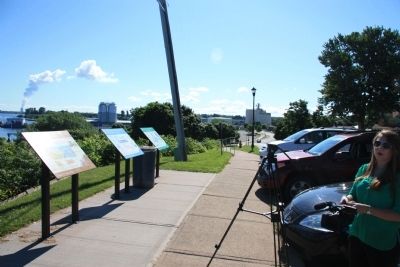Oswego in Oswego County, New York — The American Northeast (Mid-Atlantic)
Open Water = Winter Birds
Ducks, Gulls, and Predators
— Natural History —
The mouth of the river and harbor provide waterfowl and waterbirds an environment sheltered from the winter gales of Lake Ontario. The breakwalls serve as resting places for the gulls where any approaching predator may be quickly detected, while at the river's mouth, shielded from the storm waves, diving ducks harvest food.
The large flocks present provide enhanced opportunities for social interactions among individuals to aid them in finding mates for the summer. For these birds it is a winter vacation spot, a safe place to prepare for the next breeding season.
Courtship
By mid-January courtship begins in many ducks. Warm sunny days trigger courtship rituals among male ducks. Several male Common Goldeneye may display for a single female, each one trying to impress her more than his rivals. With heads pumping back and forth.
Opportunity
The large flocks of gulls and waterfowl found here attract predators, including Bald Eagle and Snowy Owl. An adult Bald Eagle will flush a flock of ducks, then hover over any sick or injured bird. The weak bird will dive repeatedly until exhausted, when it is plucked from the water by the waiting eagle. The predators provide a service to the prey species by removing sick birds and limiting the spread of disease, while these magnificent birds of prey are sustained through the winter to migrate and breed again.
Gulls
There are four species of common gulls here; Great Black-backed, Herring, Ring-billed and Bonaparte's. As the Bonaparte's depart in early winter, rare Arctic gulls including Glaucous and Iceland Gull arrive. These birds have pure white immature plumages and adults lack black wing tips. Gulls often steal food from diving ducks. Large species, such as Glaucous and Great Black-backed, may take small waterfowl and gulls.
Ducks
Diving ducks such as Common Goldeneye, Bufflehead, greater Scaup and Long-tailed Duck predominate amongst wintering waterfowl flocks. Dabblers including Mallard, American Black Duck and Gadwall occur, but the fast running river water and the deep harbor are better diving duck habitat. Ducks that can dive to depths of 20 or more meters find that food is readily available.
Erected by Great Lakes Seaway Trail.
Topics and series. This historical marker is listed in this topic list: Animals. In addition, it is included in the Great Lakes Seaway Trail National Scenic Byway series list.
Location. 43° 27.729′ N, 76° 31.195′ W. Marker is in Oswego, New
York, in Oswego County. Marker is at the intersection of Lake Street and Montcalm Street, on the left when traveling east on Lake Street. This historical marker is one of three panels of information prepared by the Great Lakes Seaway Trails, and located on the high ground, in a small roadside park, overlooking Lake Ontario, along the north side of Lake Street. Touch for map. Marker is in this post office area: Oswego NY 13126, United States of America. Touch for directions.
Other nearby markers. At least 8 other markers are within walking distance of this marker. Wreck of the David W. Mills (a few steps from this marker); Oswego West Side Forts (a few steps from this marker); Oswego Harbor West Pierhead Lighthouse (about 600 feet away, measured in a direct line); Fort George (about 800 feet away); Oswego Harbor (approx. ¼ mile away); LT-5 TUG (approx. ¼ mile away); Fort Oswego (approx. 0.3 miles away); a different marker also named Fort Oswego (approx. 0.3 miles away). Touch for a list and map of all markers in Oswego.
Credits. This page was last revised on June 16, 2016. It was originally submitted on July 16, 2014, by Dale K. Benington of Toledo, Ohio. This page has been viewed 373 times since then and 19 times this year. Photos: 1, 2, 3, 4, 5. submitted on July 26, 2014, by Dale K. Benington of Toledo, Ohio.
